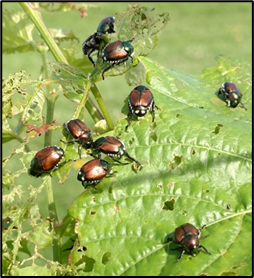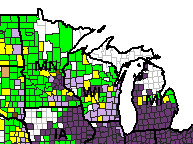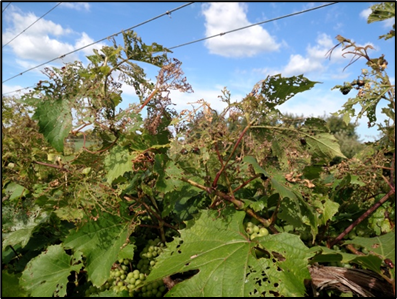First Appearance of Japanese Beetle in Southern Wisconsin

Japanese beetle adults (Figure 1; JB) have now been reported in several counties, including Dane county. Only 1 JB was observed at the West Madison Ag Research Station vineyards this week. Emergence has just begun in the last week or so and numbers will continue to increase in the next several weeks.
For many years now, JB has been described as established in the Southern half of the state and not in the Northern part of the state (Fig 2; light and dark purple counties where JB has been known to be established as of 2017). However, Krista Hamilton at DATCP recently reported that JB is now established as far north as Bayfield county and all grape and berry growers throughout the state should pay attention to this voracious herbivore.

Map from the Center for Environmental and Research Information Systems (CERIS). Purdue University. “Survey Status of Japanese beetle – Popillia japonica (All Years).” Published: 05/30/2017.
JB adults feed on grape leaves quite extensively and, for the most part, only cause cosmetic damage (Fig. 3). Grape plants are known to tolerate quite a bit of defoliation, as we all know from all the thinning you have to do each year, and research from Michigan State University suggests that 30% defoliation could be used as a threshold for implementing an insecticide application. Chemical products for JB adults control include organophosphates (e.g., Imidan), carbamates (e.g., Sevin), pyrethroids (e.g., Danitol, Baythroid, Mustang Maxx), and neonicotinoids (e.g., Assail). Organically-approved insecticides include the insect growth regulators and repellents Neemix or Azadirect, the kaolin clay Surround as a repellent, the soil born bacterial insecticide BeetleGone!, and pyrethrum (Pyganic).

As a preventative measure, soil applications of an insecticide such as imidacloprid, clothianidin, or thiamethoxan in late June as a grub control for the new eggs being laid can help reduce future populations of JB adults on your crops. However, keep in mind that this strategy has been shown to be short lived in blueberry as new adults from outside of the fields move in.
For more in depth information on the biology and management of Japanese beetle, please visit our You Tube channel and watch the webinar on “What to do now in the vineyard: post bloom”. You can view other videos there, including an interview on Asian Giant Hornet.
Thanks to Beth Workmaster for scouting at WMARS.
Happy growing season!
This article was posted in Insects and tagged Berries, Grapes, Japanese Beetles.
